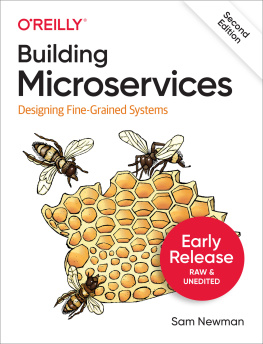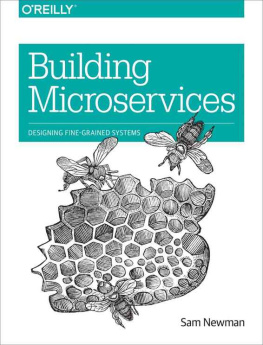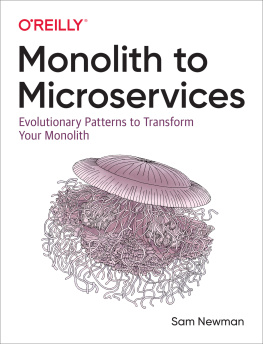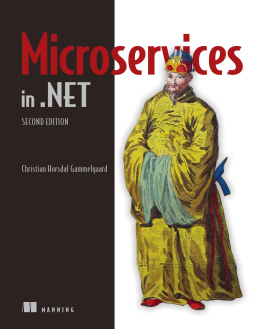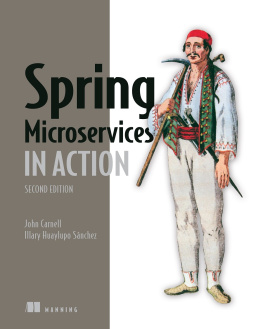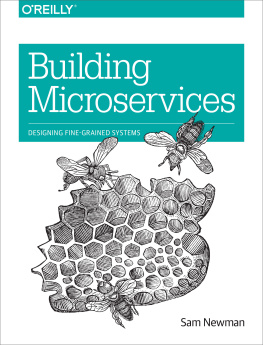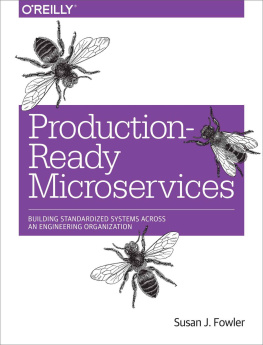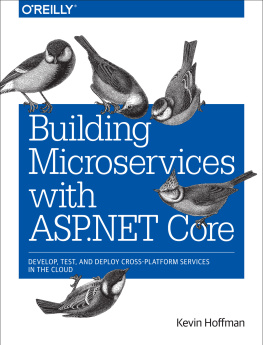Sam Newman - Building Microservices, 2nd Edition
Here you can read online Sam Newman - Building Microservices, 2nd Edition full text of the book (entire story) in english for free. Download pdf and epub, get meaning, cover and reviews about this ebook. year: 2021, publisher: OReilly Media, Inc., genre: Romance novel. Description of the work, (preface) as well as reviews are available. Best literature library LitArk.com created for fans of good reading and offers a wide selection of genres:
Romance novel
Science fiction
Adventure
Detective
Science
History
Home and family
Prose
Art
Politics
Computer
Non-fiction
Religion
Business
Children
Humor
Choose a favorite category and find really read worthwhile books. Enjoy immersion in the world of imagination, feel the emotions of the characters or learn something new for yourself, make an fascinating discovery.
- Book:Building Microservices, 2nd Edition
- Author:
- Publisher:OReilly Media, Inc.
- Genre:
- Year:2021
- Rating:5 / 5
- Favourites:Add to favourites
- Your mark:
- 100
- 1
- 2
- 3
- 4
- 5
Building Microservices, 2nd Edition: summary, description and annotation
We offer to read an annotation, description, summary or preface (depends on what the author of the book "Building Microservices, 2nd Edition" wrote himself). If you haven't found the necessary information about the book — write in the comments, we will try to find it.
Building Microservices, 2nd Edition — read online for free the complete book (whole text) full work
Below is the text of the book, divided by pages. System saving the place of the last page read, allows you to conveniently read the book "Building Microservices, 2nd Edition" online for free, without having to search again every time where you left off. Put a bookmark, and you can go to the page where you finished reading at any time.
Font size:
Interval:
Bookmark:

by Sam Newman
Copyright 2021 Sam Newman. All rights reserved.
Printed in Canada.
Published by OReilly Media, Inc. , 1005 Gravenstein Highway North, Sebastopol, CA 95472.
OReilly books may be purchased for educational, business, or sales promotional use. Online editions are also available for most titles (http://oreilly.com). For more information, contact our corporate/institutional sales department: 800-998-9938 or corporate@oreilly.com .
Acquisitions Editor: Melissa Duffield | Indexer: Judith McConville |
Development Editor: Nicole Tach | Interior Designer: David Futato |
Production Editor: Deborah Baker | Cover Designer: Karen Montgomery |
Copyeditor: Arthur Johnson | Illustrator: Kate Dullea |
Proofreader: Charles Roumeliotis |
- February 2015: First Edition
- August 2021: Second Edition
- 2021-07-23: First Release
See http://oreilly.com/catalog/errata.csp?isbn=9781492034025 for release details.
The OReilly logo is a registered trademark of OReilly Media, Inc. Building Microservices, the cover image, and related trade dress are trademarks of OReilly Media, Inc.
The views expressed in this work are those of the author, and do not represent the publishers views. While the publisher and the author have used good faith efforts to ensure that the information and instructions contained in this work are accurate, the publisher and the author disclaim all responsibility for errors or omissions, including without limitation responsibility for damages resulting from the use of or reliance on this work. Use of the information and instructions contained in this work is at your own risk. If any code samples or other technology this work contains or describes is subject to open source licenses or the intellectual property rights of others, it is your responsibility to ensure that your use thereof complies with such licenses and/or rights.
978-1-492-03402-5
[MBP]
Microservices are an approach to distributed systems that promote the use of finely grained services that can be changed, deployed, and released independently. For organizations that are moving toward more loosely coupled systems, with autonomous teams delivering user-facing functionality, microservices work incredibly well. Beyond this, microservices provide us with a huge number of options for building out systems, giving us a lot of flexibility to ensure our system can change to meet the needs of the users.
Microservices arent without significant downsides, though. As a distributed system, they bring a host of complexity, much of which may be new even to experienced developers.
The experiences of people all over the world, along with the emergence of new technologies, are having a profound effect on how microservices are used. This book brings these ideas together, along with concrete, real-world examples, to help you understand whether microservices are right for you.
The scope of Building Microservices is broad, as the implications of microservice architectures are also broad. As such, this book should appeal to people interested in aspects of design, development, deployment, testing, and maintenance of systems. Those of you who have already embarked on the journey toward finer-grained architectures, whether for a greenfield application or as part of decomposing an existing, more monolithic system, will find plenty of practical advice to help you. This book will also help those of you who want to know what all the fuss is about, so that you can determine whether microservices are right for you.
At one level, I wrote this book because I wanted to make sure that the information in the first edition remained up to date, accurate, and useful. I wrote the first edition because there were really interesting ideas that I wanted to share. I was fortunate that I was in a place where I had the time and support to write the first edition, and that I could do so from a fairly unbiased viewpoint because I didnt work for a big technology vendor. I wasnt selling a solution, and I hoped I wasnt selling microservices eitherI just found the ideas fascinating, and I loved unpacking the concept of microservices and finding ways of sharing it more broadly.
When I really break it down, I wrote a second edition for two main reasons. Firstly, I felt I could do a better job this time. Ive learned more, and I am hopefully a bit better as a writer. But I also wrote this second edition because I played a small part in helping these ideas hit the mainstream, and as such I have a duty of care to make sure they are presented in a sensible, balanced way. Microservices have become, for many, the default architectural choice. This is something that I think is hard to justify, and I wanted a chance to share why.
This book isnt pro microservices, nor is it anti microservices. I just want to make sure that Ive properly explored the context in which these ideas work well and shared the problems they can cause.
I wrote the first edition of Building Microservices in around a year, starting at the beginning of 2014, with the book being released in February 2015. This was early in the microservices story, at least in terms of the wider industrys awareness of the term. Since then, microservices have gone mainstream in a way that I couldnt have predicted. With that growth has come a much wider set of experiences to draw on, and more technology to explore.
As I worked with more teams in the wake of the first edition, I started to refine my thinking around some of the ideas associated with microservices. In some cases, this meant that ideas that were only at the periphery of my thinking, like information hiding, started to become more clear as foundational concepts that needed to be better highlighted. In other areas, new technology presented both new solutions and new problems for our systems. Seeing so many people flock to Kubernetes in the hope that it would solve all their issues with microservice architectures certainly gave me pause for thought.
Additionally, Id written the first edition of Building Microservices to provide not just an explanation of microservices, but also a broad overview of how this architectural approach changes aspects of software development. So as I looked more deeply at aspects around security and resiliency, I found myself wanting to go back and expand on those topics that are increasingly important to modern software development.
Thus in this second edition, I spend more time sharing explicit examples to better explain the ideas. Every chapter has been reexamined, and every sentence reviewed. Not a lot of the first edition remains in terms of concrete prose, but the ideas are all still here. Ive tried to be clearer in my own opinions, while still recognizing that there are often multiple ways of solving a problem. This has meant expanding the discussion of inter-process communication, which is now split across three chapters. I also spend more time looking at the implications of technologies such as containers, Kubernetes, and serverless; as a result, there are now separate build and deployment chapters.
Font size:
Interval:
Bookmark:
Similar books «Building Microservices, 2nd Edition»
Look at similar books to Building Microservices, 2nd Edition. We have selected literature similar in name and meaning in the hope of providing readers with more options to find new, interesting, not yet read works.
Discussion, reviews of the book Building Microservices, 2nd Edition and just readers' own opinions. Leave your comments, write what you think about the work, its meaning or the main characters. Specify what exactly you liked and what you didn't like, and why you think so.

